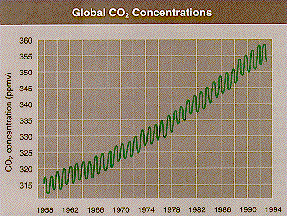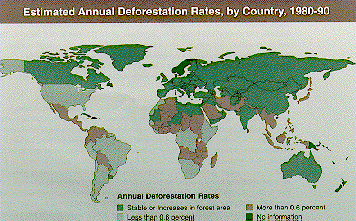FIGURE 15

SOURCE: Intergovernmental Panel on Climate Change, Climate Change 1994
- Radiative Forcing of Climate Change, J.T. Houghton et al., eds.
(Cambridge: Cambridge University Pre5s, 1995), p. 43.
It is clear that the United States cannot solve the potential problem
of climate change alone. But it also is clear that unless the
industrialized nations demonstrate the benefits of a different
development path, there will be little incentive for the rest of the
world to follow.
Threats to the global stock of biodiversity represent another global
environmental challenge. Although the risks and implications for the
United States (as well as its own contribution to the problem) may seem
vague and uncertain, the economic and environmental effects could be
profound. Economic benefits from wild species make up an estimated 4.5
percent of the U.S. gross domestic product. Fisheries contribute about 100
million tons of food worldwide. One-fourth of all prescriptions
dispensed in the United States contain active ingredients extracted from
plants, and more than 3,000 antibiotics are derived from microorganisms.
Further, nature tourism generates an increasing percentage of tourism
revenues worldwide. Yet, for all its value, biodiversity often takes
a back seat in many economic development plans. Tropical forests house
between 50 and 90 percent of all species on Earth, but because of forest
clearing, 5 to 10 percent of the tropical forest species may be faced
with extinction within the next 30 years.[6] (See figure 16.)
Around the globe people who depend on the sea for a living are already
witnessing a decline in the productivity of many of the world's most
valuable fisheries. As with climate change, one nation cannot solve the
problem alone, and the potential for economic harm is huge.
In accepting the challenges of leadership posed by its wealth, strength,
know-how, and history, the United States must first adopt effective
domestic policies to achieve sustainable development so that it can
demonstrate that a better path to progress is possible.
Falling short of its own goals may signal to the world the
ineffectiveness of free institutions to create environmentally sound
economic development that equitably distributes the benefits of growing
prosperity. If the United States believes that free institutions are
the best means for pursuing human aspirations, it must show that these
institutions can respond to the great changes taking place.
More than 100 nations have established national councils on sustainable
development similar to the U.S. President's Council on Sustainable
Development; they seek to create consensus and shape policies to bring
together economic, environmental, and equity goals.[7]
Some, like the Canadian and Australian Roundtables, began their work
several years before the U.S. Council. Most have been organized in
response to the 1992 Earth Summit, the United Nations Conference on
Environment and Development. Each of the councils is addressing the
relationship of human well-being, economic progress, and the environment
within the fabric of the conditions, needs, heritage, and politics of
its own country. Their council representatives have said--in many
different ways--that if the United States fails, they cannot succeed; but
if the United States embraces the idea of sustainability, they believe
their own nations will as well.
Because the United States is linked to the world by inter-related
economic, environmental, and security interests, it cannot simply turn
inward. The nation will achieve much that is in its interest by arguing
the case for and assisting the transition to global sustainability. It
can create markets for U.S. technology, foster equitable conditions
under which U.S. industries and workers can compete, and build fair
agreements for action to address global problems that affect the United
States and its citizens. International engagement for sustainability is
a task for government in its relations with other governments, but it
is also a task for other parts of society.
For decades, and with considerable success, America has provided aid to
nations to encourage development, fight disease, build democracy, and
reduce environmental damage. The majority of that aid has come from
government, but U.S. philanthropic organizations also have channeled
billions of dollars of voluntary contributions into national and global
efforts to meet human needs and protect the future. Leading U.S.
companies have been influential in moving their industries toward
openness and the application of consistent codes of responsible global
stewardship. Nongovernmental organizations have helped to spur the
creation of strong independent voices in debates on development,
environment, and social policies around the world. Both official and
unofficial roles are essential to the process of international change.
FIGURE 16

There must be several elements to this national engagement. One
element is having strong and effective bilateral and multilateral
development assistance agencies. Through organizations such as the U.S.
Agency for International Development, the United Nations, the Global
Environment Facility, and the various international organizations
charged with helping implement the international environmental accords,
the United States can demonstrate its commitment to global development
paths that make sense for both this country and the rest of the world.
The United States can also continue to play a key role in helping
developing countries confront the critical problems this nation has
already solved at home, such as the removal of lead from gasoline and
the development of environmental assessment techniques. Financial
support is one way for the United States to make credible, substantive,
and analytical contributions to the work of multilateral institutions and
encourage broader participation by other countries.
Second, the United States is a signatory to the international conventions
or treaties that are designed to promote common actions to reduce the
risks of climate change and biodiversity loss--two of a growing list of
international accords to address global environmental concerns.[8] Yet, the United States has not ratified the U.N.
Convention on Biological Diversity--the only major industrialized country
that has not done so--even though ratification was supported by a broad
cross section of U.S. industry and environmental groups. As a result, the
United States faces the risk of not being able to participate in the
treaty or help shape the treaty's evolution. Further, the United States
may forgo potential economic benefits from the import of genetic
resources. The international environmental treaties may not be perfect
from many different perspectives, but they do offer a framework for
nations to use to move forward together when there is little incentive to
move alone. America will derive the greatest benefit in support of its
economic and environmental interests by participating in these treaties
as well as in the full range of international development assistance
processes.
Third, this nation must not diminish either the importance of scientific
research for domestic and international fronts or the importance of the
U.S. role in such research. To develop treaties to deal with new
concerns and issues effectively, the scientific understanding of the
problems and the possible responses to them must continue to be
improved. Therefore, the United States should continue to support
research and encourage other nations to participate more in
international research on critical issues relevant
to health and the environment.
Finally, but no less importantly, this nation should continue to promote
and encourage global trading systems that mutually reinforce
environmental protection and other social development goals. In recent
years, initial steps have been taken to incorporate environmental
provisions into regional and multilateral agreements designed to
reduce trade barriers and improve equitable access to global markets.
These agreements may serve to enhance U.S. economic well-being as well
as that of other nations and to promote, in a broader sense, greater
global stability. Much still needs to be done, however, in reconciling
trade and environmental objectives in an increasingly integrated
world economy. This is not just a job for governments, but requires the
resources and commitment of the industrial community and the private
sector as a whole. Improved economic health and political stability can
provide greater resources for environmental protection and a more
effective coordinated global approach to the challenges that the nations
of the world face together.

GLOBAL CLIMATE CHANGE |
|---|
The Earth has a blanket of gases that keeps its temperature at an
average of about 600 F.[9] Without this natural
greenhouse effect, the Earth's average temperature would be about O F,
and the Earth itself would be frozen solid. Life as we know it would
not be possible.
The greenhouse effect is the result of naturally occurring gases
in the atmosphere, principally water vapor, carbon dioxide, methane, and
nitrous oxide. These gases trap some of the Earth's outgoing infrared
radiation and, like a vast blanket, keep the Earth wormer than it
otherwise would be. With the industrialization that has occurred over
the past 150 years, the atmospheric concentrations of greenhouse gases
have increased, and new greenhouse gases (such as chlorofluorocarbons
that deplete the ozone layer) have been added to the atmosphere.
The most important greenhouse gas influenced by human activity is carbon
dioxide. Concentrations of carbon dioxide have increased by about 30
percent over preindustrial levels. Buildup of this gas results
primarily from the burning of fossil fuels and deforestation.
The buildup of greenhouse gases in the atmosphere is expected to
lead to an enhanced greenhouse effect popularly referred to as global
warming. Carbon dioxide accounts for the great majority of global
warming; because of the enormous complexity of the Earth's
climate system, it is not possible to predict with certainty the
temperature rise or other effects that will occur as concentrations of
greenhouse gases increase. Generally though, models predict that global
worming will lead to higher surface temperatures and to a rise in sea
levels. They also suggest more severe droughts and/or floods in some
places and the possibility of more extreme rainfall events. The Earth has
wormed by about 10 F since preindustrial times, and the international
scientific community now believes that the balance of evidence suggests
a discernable human influence on global climate.
Efforts to reduce the risks of global warming include initiatives
to reduce man-made emissions of greenhouse gases domestically and through
cooperative efforts with other countries. One such initiative is the
recently developed pilot program, the United States Initiative on Joint
Implementation.[10] In addition, efforts should be
pursued to mitigate potential effects of global warming and to adapt to
those effects. Since the world depends on fossil fuels (which account
for most carbon dioxide emissions) for 90 percent of its energy, the
implications of global warming could be profound. If the risks of
warming are judged to be too great, then nothing less than a drastic
reduction in the burning of coal, oil, and natural gas would be
necessary.
|
PR0TECTING A FITE OF AUTUMN |
As days grow colder and shadows longer, ducks and geese fill the
skies of North America on their migratory journey south. For some, it's
a very long trip. The tiny blue-winged teal, for example,
starts from the northern plains of Canada, passes over wheatfields and
cornfields of the United States, crosses the Gulf of Mexico, and comes
to rest at wintering grounds in Mexico and parts of
South America.
This rite of autumn may not be witnessed by future generations if
important wetlands habitats along migratory routes continue to be
drained and developed. Ten years ago, North American
waterfowl populations had plummeted to record lows. More than half --
and by some estimates
much more -- of 215 million acres of U.S. wetlands habitat within the
lower 48 states had disappeared since the arrival of the first European
settlers. Across Canada, estimates of wetlands losses for
different areas range from 29 to 71 percent over the same period.
Because efforts to safeguard migratory waterfowl cannot succeed
without international cooperation, the governments of the United States,
Canada, and Mexico have been working on a strategy to protect, restore,
and enhance waterfowl habitat. In 1986, Canada and the United States
established the North American Waterfowl Management Plan, which
recognizes that the recovery and sustainability of waterfowl populations
depend on maintaining wetlands and associated ecosystems throughout the
North American continent. Mexico became a participant in this plan in 1994.
The strength of the North American Waterfowl Management Plan lies
in the partnerships it encourages among federal, state, provincial, and
local governments; businesses; conservation organizations; and
individual citizens. To date, this wide array of public
and private partners has undertaken 12 joint ventures involving habitat
and two directed toward individual species -- Arctic nesting
geese and black ducks. None of these projects has been mandated by or
subject to regulation and participation is voluntary. Since 1986, over
half a billion dollars has been invested in plan projects.
More than 2 million acres of habitat have been protected, and 2.5
million acres restored or enhanced.[11]
"Migratory birds are a natural resource we share," says
Francisco Flores Verdugo, a professor at the National University of
Mexico and member of Mexico's plan committee. "They have an impact
on the economic and cultural aspects of all three countries and have to
be managed multinationally for optimal conservation." Says Frank
Dunstan, vice president for wildlife sanctuaries at the National
Audubon Society, "One of the great successes of the plan is that its
conservation impact expands beyond just waterfowl and protects all sorts
of wetlands wildlife and species."
|

